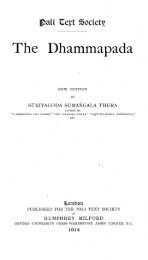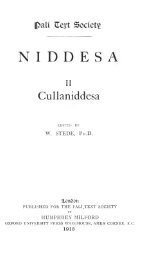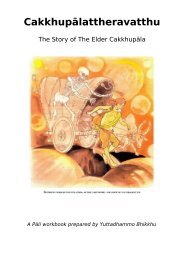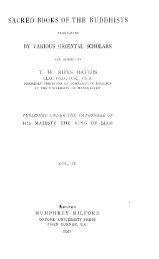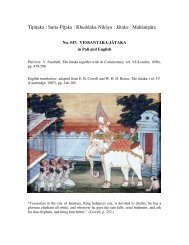Lessons In Practical Buddhism - Sirimangalo.Org
Lessons In Practical Buddhism - Sirimangalo.Org
Lessons In Practical Buddhism - Sirimangalo.Org
Create successful ePaper yourself
Turn your PDF publications into a flip-book with our unique Google optimized e-Paper software.
people try to argue that, based on teachings like this,<br />
<strong>Buddhism</strong> is an inherently negative religion.<br />
It is quite dishonest to say such a thing, though; it means<br />
such people haven’t really made any effort to study the<br />
Buddha’s teaching. The Buddha said that the mind is pure in<br />
and of itself – it’s already pure. The nature of the mind, the<br />
nature of reality? There is nothing wrong with it. There’s<br />
nothing that needs to be changed. We can be happy all the<br />
time, but for one important thing – suffering. Once we’re<br />
free from suffering, what should we worry about? What else<br />
should we need? If there were no suffering, why would we<br />
have to look for happiness? All we would have is happiness<br />
and calm. If there were never a state of suffering, then all<br />
that would be left is happiness and calm. Sometimes calm,<br />
sometimes happiness – never suffering. So, all you have to<br />
do is think for a second: what are the implications of not<br />
suffering?<br />
This is why these saññas are most important. Negative<br />
things are most important, because they help us to let go of<br />
our defilements. They help us to let go of our craving, which<br />
is the cause of suffering. Once we see that the objects of our<br />
attachment are not really worth clinging to, not worth<br />
worrying about, not worth trying to control — “may they be<br />
like this; may they not be like that” – once we can see the<br />
suffering inherent in clinging, that true happiness doesn’t<br />
exist in anything outside of ourselves, only then can we find<br />
true peace and happiness.<br />
aniccasaññā<br />
The first two perceptions, aniccasaññā and anattasaññā,<br />
mean to see that the five aggregates and six sense bases<br />
are impermanent and non-self. Aniccasaññā is based on the<br />
five aggregates and anattasaññā is based on the six senses,<br />
but they’re actually saying the same thing. The aggregates<br />
and the senses are both impermanent and non-self. <strong>In</strong> the<br />
Anattalakkhaṇa sutta, the Buddha talks about the five<br />
aggregates as being non-self, but he explains it by saying<br />
they are impermanent, and if they’re impermanent, can you<br />
really say they’re self? What we mean by impermanent is not<br />
just that they change, but they arise and they cease.<br />
82



